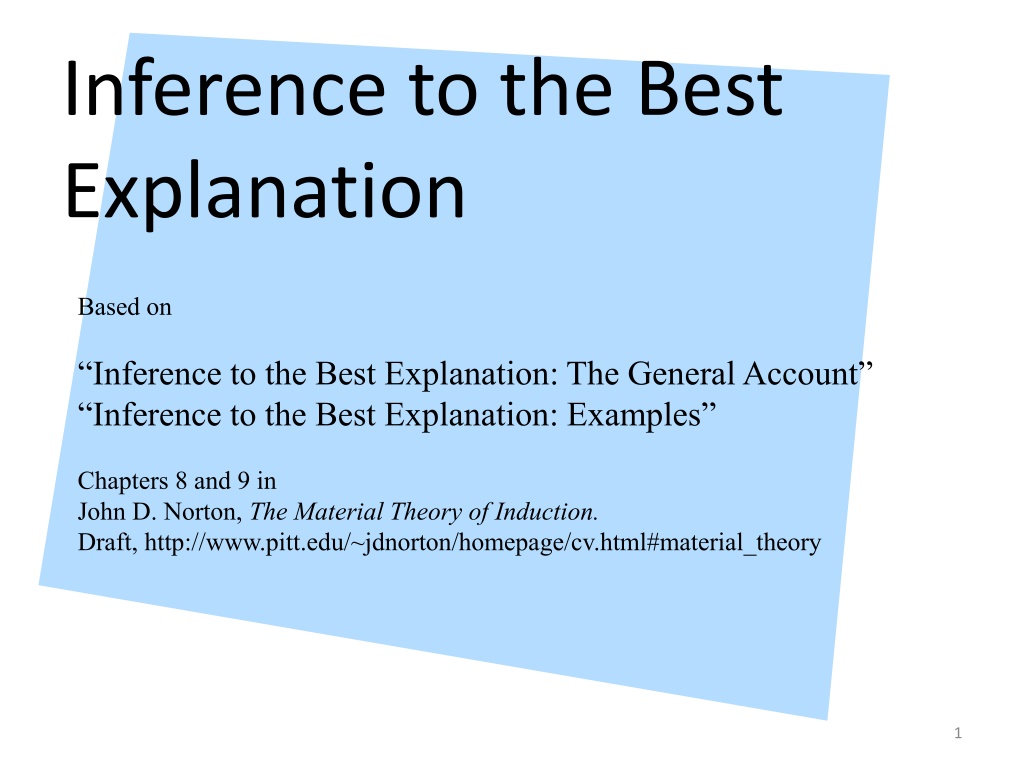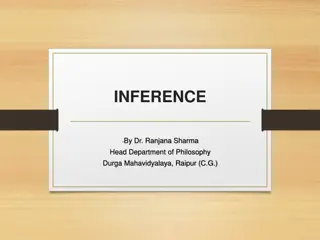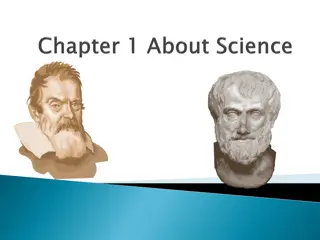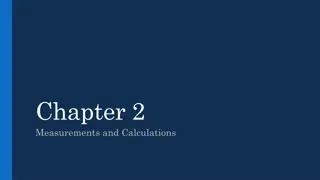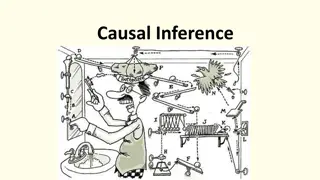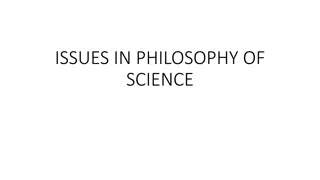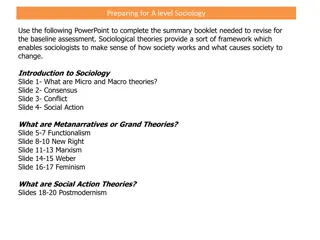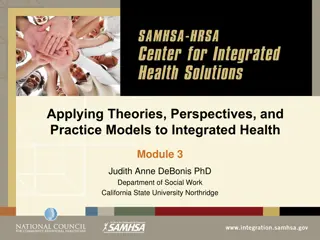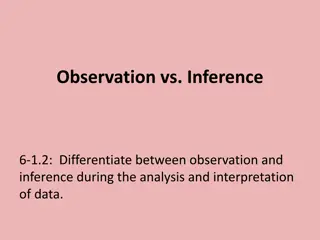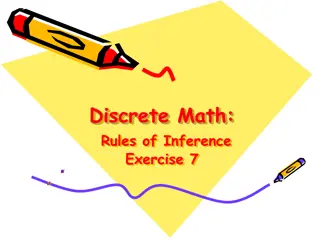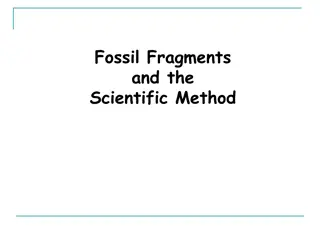Inference to the Best Explanation - Examples in Scientific Theories
The concept of Inference to the Best Explanation (IBE) emphasizes the importance of theories or hypotheses that not only predict evidence but also provide the best explanation for it. Illustrated through examples from Darwin's theory of natural selection and Einstein's General Theory of Relativity regarding the anomalous motion of Mercury, IBE highlights the significance of explanatory prowess in gaining inductive support. Despite challenges in defining concepts and selecting appropriate examples, IBE remains a valuable tool in evaluating scientific theories and explanations.
Download Presentation

Please find below an Image/Link to download the presentation.
The content on the website is provided AS IS for your information and personal use only. It may not be sold, licensed, or shared on other websites without obtaining consent from the author. Download presentation by click this link. If you encounter any issues during the download, it is possible that the publisher has removed the file from their server.
E N D
Presentation Transcript
Inference to the Best Explanation Based on Inference to the Best Explanation: The General Account Inference to the Best Explanation: Examples Chapters 8 and 9 in John D. Norton, The Material Theory of Induction. Draft, http://www.pitt.edu/~jdnorton/homepage/cv.html#material_theory 1
The basic idea of IBE = Abduction A theory or hypothesis must do more than merely accommodate or predict the evidence. If it is to accrue inductive support from the evidence, it must explain it. Since multiple explanations are possible, we are enjoined to infer to the best of them. Greater explanatory prowess confers greater inductive support. 2
Example: Darwin Darwin (1876, p. 414:) theory. How strange it is that a bird, under the form of a woodpecker, should prey on insects on the ground; that upland geese which rarely or never swim, should possess webbed feet; that a thrushlike bird should dive and feed on sub-aquatic insects; and that a petrel should have the habits and structure fitting it for the life of an auk! and so in endless other cases. But on the view of each species constantly trying to increase in number, with natural selection always ready to adapt the slowly varying descendants of each to any unoccupied or ill-occupied place in nature, these facts cease to be strange, or might even have been anticipated. Many other facts are, as it seems to me, explicable on this The key evidential claim (Darwin, 1876, p. 421) It can hardly be supposed that a false theory would explain, in so satisfactory a manner as does the theory of natural selection, the several large classes of facts above specified. 3
Einstein: Anomalous Motion of Mercury In a paper entitled Explanation of the Perihelion Motion of Mercury from the General Theory of Relativity, he wrote: In the present paper, I find an important confirmation of this most radical theory of relativity; that is, it turns out that the secular rotation of Mercury s orbit in the direction of the orbital motion, discovered by Leverrier, which amounts to about 45 in a century, is explained qualitatively and quantitatively, without having to posit any special hypothesis at all. 4
Survey of literature on IBE First, the basic concepts invoked remain imprecisely defined. Worse, efforts to explicate these concepts trigger a death spiral of multiplying problems: clarifying one concept requires introduction of several new ones that in turn require their own clarifications. Second, the selection of illustrative examples is commonly poor. Examples in science are often just named or glossed hastily and claimed to support some favored conclusion. Third, there is a strong tendency to employ illustrative examples that involve human action. They are poor surrogates for the corresponding scientific examples. There is no identification of some special property of explanation that makes it inductively potent. Instead, we have a multiplicity of competing accounts of explanation with no obvious unity. 5
Peirce and abductive inference The much-quoted statement of it comes later in Peirce s writings, from his 1903 Harvard Lecture, Pragmatism as the Logic of Induction (1932, 5.189): Long before I classed abduction as an inference it was recognized by logicians that the operation of adopting an explanatory hypothesis which is just what abduction is was subject to certain conditions. Namely, the hypothesis cannot be admitted, even as a hypothesis, unless it be supposed that it would account for the facts of some of them. The form of the inference, therefore, is this: The surprising fact, C, is observed; But if A were true, C would be a matter of course, Hence, there is reason to suspect that A is true. Thus, A cannot be abductively inferred, or if you prefer the expression, cannot be abductively conjectured until its entire content is already present in the premises, If A were true, C would be a matter of course. 6
Harmans Inference to the Best Explanation Harman s (1965) paper Inference to the Best Explanation, from which the now popular label derives. His account of the inference is as follows (1965, p.89): In making this inference one infers, from the fact that a certain hypothesis would explain the evidence, to the truth of that hypothesis. In general, there will be several hypotheses which might explain the evidence, so one must be able to reject all such alternative hypotheses before one is warranted in making the inference. Thus one infers, from the premise that a given hypothesis would provide a better explanation for the evidence than would any other hypothesis, to the conclusion that the given hypothesis is true. 7
Harmans Inference to the Best Explanation There is, of course, a problem about how one is to judge that one hypothesis is sufficiently better than another hypothesis. Presumably such a judgment will be based on considerations such as which hypothesis is simpler, which is more plausible, which explains more, which is less ad hoc, and so forth. I do not wish to deny that there is a problem about explaining the exact nature of these considerations; I will not, however, say anything more about this problem. 8
Thagards Criteria Laudable range of real examples from science: Darwin s long argument in his Origin of Species; Lavoisier s care for the oxygen theory of combustion; The wave theory of light, as developed by Huygens in the seventeenth century; and Young and Fresnel in the nineteenth century; Newton s explanation of the motion of planets and satellites; Halley s Newtonian prediction of the return a comet; Young s account of di-polarization; Fresnel s account of polarization through transverse waves; General relativity s treatment of the anomalous perihelion motion of Mercury, the gravitational bending of light and the gravitational red shift of light; and Quantum mechanics and its success with atomic spectra, magnetism, the solid state of matter, the photoelectric effect and the Compton. 9
Thagards Criteria The focus is not on what explanation is, but on how to judge which is the better explanation. Three, possibly conflicting criteria: consilience, simplicity and analogy The conflict is ultimately unresolved: Consilience and simplicity militate against each other, since making a theory more consilient can render the theory less simple, if extra hypotheses are needed to explain the additional facts. The criterion of analogy may be at odds with both consilience and simplicity, if a radically new kind of theory is needed to account simply for all the phenomena. 10
Liptons Monograph We should infer not to the most likely explanation but to the loveliest explanation. Loveliness derives from virtues: mechanism, precision, scope, simplicity, fertility or fruitfulness, and fit with background belief (p.122) as well as unification (p. 139). The account is limited to causal explanation. Causation remains an unexplicated term. There are many non-scientific examples and all but one are not recounted in detail. The one extended example is Semmelweis diagnosis of childbed fever. It is a poor fit with IBE. It fits better with Mill s methods. 11
Material Analysis There is no unifying, formal account of inference to the best explanation. Inferences to the best explanation comprise at best a collection of loosely similar inductive inferences. For the fullest analysis, each should be treated individually, on a case by case basis. The warrant for each IBE is found in the background facts pertinent to each case. 12
Two Step Reconstruction Step 1. Preference for the Better Explanation The favored hypothesis is adequate to the evidence, most commonly in the sense that it deductively entails the evidence. The foils, that is, the alternatives, are judged inadequate in one of two ways: Contradiction: The evidence at hand may directly contradict the alternative; or the evidence supplemented by specific background facts may contradict the alternative. Evidential debt: to accept the alternative requires us to accept further assumptions for which we have no evidence. The essential point is that the favoring invokes no explanatory notions. 13
Two Step Reconstruction Step 2. From Comparative to Absolute: Better is Best The surest case arises when background assumptions assure us that the hypotheses or theories we have considered are exhaustive. The most difficult case is the most common. It is when the inference from better to absolute best is made, even though the scientist have no clear grasp of the full range of hypotheses or theories possible. 14
Examples Matter Lipton (2004, p. 6) gives the time-worn example: Faced with tracks in the snow of a certain peculiar shape, I infer that a person on snowshoes has recently passed this way. Once one has seen the distinctive imprints left by snowshoes, there is really only one account to be given of their origin. We might invent fanciful scenarios just to drive home that there is no real choice. Lipton (2004, p. 56) shows how it is done: Of course, there is always more than one possible explanation for any phenomenon the tracks might have instead been caused by a trained monkey on snowshoes, or by the elaborate etchings of an environmental artist so we cannot infer something simply because it is a possible explanation. It must somehow be the best of competing explanations. However, entertaining these alternatives rapidly becomes a perfunctory exercise in eliminating the fanciful. We might well dismiss them as comic relief. 15
Examples Matter Here these human examples are quite unlike the real scientific examples. The alternative hypotheses or theories in the scientific cases were not jokes. Prevailing over them is, almost everywhere, the greater challenge 16
Lyells Uniformitarian Geology Principles of Geology, Being an Attempt to Explain the Former Changes of the Earth's Surface, by Reference to Causes Now in Operation Lyell s approach In our attempt to unravel these difficult questions, we shall adopt a different course, restricting ourselves to the known or possible operations of existing causes; feeling assured that we have not yet exhausted the resources which the study of the present course of nature may provide, and therefore that we are not authorized, in the infancy of our science, to recur to extraordinary agents. Contrasted with that of the catastrophists the opposite method, that of speculating on a former distinct state of things, has led invariably to a multitude of contradictory systems, which have been overthrown one after the other, which have been found quite incapable of modification, and which are often required to be precisely reversed. 18
Lyells Uniformitarian Geology Lyell seeks to establish two facts: 1. It is possible that present geological features arose over long time periods from causes now operating. and 2. It is unlikely that any other admissible account can accommodate their origin. These two facts are sufficient to warrant acceptance of Lyell s uniformitarianism. Lyell has a direct and telling objection to theories of this second type: they are taking on an undischarged evidential debt. If fossil shells were formed by some plastic virtue or mysterious agency, then we are owed independent evidence that such virtues and agencies exist. If high mountains were thrown up suddenly by cataclysmic forces, we are again owed independent evidence that such forces existed. Lyell s theory takes on no corresponding evidential debt. We are assured of the existence of the causes he employs since they are in operation now. 19
Einstein and the Anomalous Perihelion of Mercury In a paper entitled Explanation of the Perihelion Motion of Mercury from the General Theory of Relativity, he wrote: In the present paper, I find an important confirmation of this most radical theory of relativity; that is, it turns out that the secular rotation of Mercury s orbit in the direction of the orbital motion, discovered by Leverrier, which amounts to about 45 in a century, is explained qualitatively and quantitatively, without having to posit any special hypothesis at all. 20
Elimination of Four Foils Einstein (1915, p. 831): E. Freundlich has recently written a noteworthy paper (Astr. Nachr. 4803, Bd. 201 June 1915) on the impossibility of satisfactorily explaining the anomalous motion of Mercury on the basis of the Newtonian theory. Freundlich s paper listed four ways the astronomers had then tried to explain the anomalous motion. He concluded that none succeeded. That is (1915, p. 51): in the explanation of the existing contradiction between theory and experiment, we have progressed no further than since the time of Newcomb. His final, concluding sentence (p. 56) is: How the anomalies of these inner 4 planets really come about has unfortunately up to now not been answered thoroughly. 21
Elimination of Four Foils 1. Unknown planet or multiple planets in a ring. No suitable configuration fits observations and known anomalies. 2. Flattening of the sun. Insufficient flattening observed. 3. Gravity dilutes as 1/r2+ . A deviation d large enough disturbs other planets and moon. 4. Zodiacal light (distributed matter near sun) No distribution fits all observations, including possible drag on planetary motion. 22
Why Loveliness as an Explanatory Virtue is Overrated Of all theories in modern physics, general relativity is distinctive in the praise it receives for its immense conceptual simplicity and scope. It is, by any measure, a lovely theory. A simple thought experiment reveals just how little the loveliness matters. Imagine that, contrary to history, the nineteenth century astronomers did discover a new planet Vulcan in just the place expected from Mercury s anomalous motion. The discovery would be celebrated as a great triumph of Newtonian physics. General relativity, however, now finds itself in great difficulty. For the anomaly in Mercury s motion has disappeared, but general relativity still requires an additional advance of the perihelion of 43 seconds of arc per century, beyond what is predicted by the fullest Newtonian account. The observed motion of Mercury, in this fable, now threatens to refute general relativity. 23
